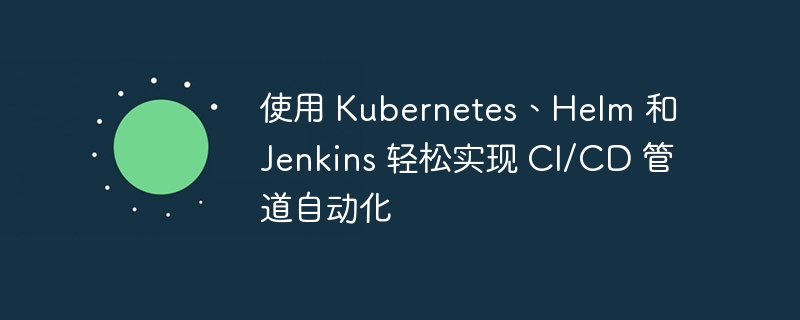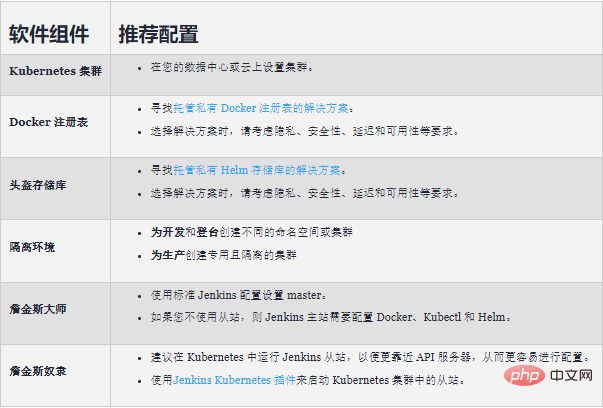Easily automate your CI/CD pipeline with Kubernetes, Helm, and Jenkins
In a fast-paced software development environment, rapid release is crucial. CI/CD (Continuous Integration and Continuous Deployment) pipelines automate the deployment process and simplify the movement of code from development to production. This article focuses on setting up a fully automated CI/CD pipeline using Jenkins, Helm, and Kubernetes in a Kubernetes environment, including: environment setup, steps to automate pipeline builds, and deployment to development, staging, and production environments. By implementing this automated process, developers can focus on code development while leaving complex infrastructure management to automation, improving deployment efficiency and reliability.

#Releasing releases quickly is crucial these days. Gone are the days when developers waited weeks to deploy code to a test environment. More than ever, people need fast deployment cycles that move code seamlessly from development to production without any hiccups.
The reality, however, is that developers often find themselves bogged down in the complexities of infrastructure management and the tedium of manual deployment processes. They crave a solution that allows them to focus solely on code and leave the complex deployment work to automation.
This is where continuous integration and continuous deployment (CI/CD) pipelines come into play. These automated workflows streamline the entire deployment process from code compilation to testing to deployment, allowing developers to deliver updates at lightning speed. However, implementing a robust CI/CD pipeline has historically been challenging, especially for organizations with legacy applications.
Why use Kubernetes for deployment?
This is where Kubernetes, the leading container orchestration platform, shines. Kubernetes revolutionizes deployment environments by providing a scalable and flexible infrastructure for managing containerized applications. When combined with Helm, the Kubernetes package manager, developers get a powerful toolkit to simplify application deployment and management.
In this article, we take a deep dive into the complexities of setting up a fully automated CI/CD pipeline for containerized applications using Jenkins, Helm, and Kubernetes. We'll guide you through the process of configuring your environment, optimizing your pipeline for greater efficiency, and provide practical templates for customizing your own deployment workflow. After reading this guide, you'll have the knowledge and tools you need to accelerate your software delivery cycles and stay ahead of today's competitive landscape. Let’s dive in!
Automated CI/CD Pipeline Setup
This 6-step workflow will easily automate your CI/CD pipeline to quickly and easily use Jenkins, Helm, and Kubernetes deploy.
To get familiar with the Kubernetes environment, I mapped the traditional Jenkins pipeline with the main steps of my solution.
Note: This workflow also applies to implementing other tools or partial implementations.
Set up the environment
Configure the software components
Before creating the automation pipeline, you need to set up and configure the software according to the following configuration Components:

Preparing Your Application
Please follow these guidelines when preparing your application:
-
Package your application in a Docker image according to Docker best practices.
To run the same Docker container in any of the following environments: development, staging, or production, separate processes and configurations as follows:
For development: Create a default configuration.
For staging and production: Create a non-default configuration using one or more of:
can be mounted at runtime to Configuration files in the container.
Environment variables passed to the Docker container.
Practical Application of a 6-Step Automated CI/CD Pipeline in Kubernetes
General Assumptions and Guidelines
These steps are consistent with best practices when running a Jenkins agent.
Assign a dedicated agent to build the application and an additional agent to perform deployment tasks. This depends on your good judgment.
Run the pipeline for each branch. To do this, use Jenkins multi-branch pipeline jobs.
Steps
1. Get the code from Git
Developers push the code to Git , which triggers Jenkins to build the webhook.
Jenkins pulls the latest code changes.
2. Run the build and unit test
Jenkins runs the build.
The Docker image of the application is created during the build. - Run tests against a running Docker container.
3. Publish Docker image and Helm Chart
The application's Docker image is pushed to the Docker registry.
Helm charts are packaged and uploaded to the Helm repository.
4. Deploy to development
Use the published Helm chart to deploy the application to the Kubernetes development cluster or namespace.
Run tests against a deployed application in a Kubernetes development environment.
5. Deploy to staging
Use published Helm charts to deploy the application to a Kubernetes staging cluster or namespace.
Run tests against deployed applications in a Kubernetes staging environment.
6. [Optional] Deploy to production environment
If the application meets the defined conditions, the application will be deployed to the production cluster . Note that you can set up a manual approval step.
Run sanity tests against deployed applications.
You can perform a rollback if necessary.
Create your own automated CI/CD pipeline
Feel free to use the following sample frameworks I put together for this purpose to build something like Implementation:
for a Jenkins Docker image running on Kubernetes.
A 6-step CI/CD pipeline for a simple static website application based on the official nginx Docker image.
Conclusion
Using Jenkins, Helm, and Kubernetes to automate CI/CD pipelines is not only a trend, but a necessity in today’s fast-paced software development Necessities in the environment. By leveraging these powerful tools, you can streamline your deployment process, reduce manual errors, and accelerate time to market.
As you embark on the journey to implement a fully automated pipeline, remember that continuous improvement is key. Regularly evaluate and optimize your workflow to ensure maximum efficiency and reliability. With the right tools and practices, you'll be equipped to meet the demands of modern software development and stay ahead of the competition.
The above is the detailed content of Easily automate your CI/CD pipeline with Kubernetes, Helm, and Jenkins. For more information, please follow other related articles on the PHP Chinese website!

Hot AI Tools

Undresser.AI Undress
AI-powered app for creating realistic nude photos

AI Clothes Remover
Online AI tool for removing clothes from photos.

Undress AI Tool
Undress images for free

Clothoff.io
AI clothes remover

Video Face Swap
Swap faces in any video effortlessly with our completely free AI face swap tool!

Hot Article

Hot Tools

Notepad++7.3.1
Easy-to-use and free code editor

SublimeText3 Chinese version
Chinese version, very easy to use

Zend Studio 13.0.1
Powerful PHP integrated development environment

Dreamweaver CS6
Visual web development tools

SublimeText3 Mac version
God-level code editing software (SublimeText3)

Hot Topics
 1386
1386
 52
52
 How to update the image of docker
Apr 15, 2025 pm 12:03 PM
How to update the image of docker
Apr 15, 2025 pm 12:03 PM
The steps to update a Docker image are as follows: Pull the latest image tag New image Delete the old image for a specific tag (optional) Restart the container (if needed)
 How to create a mirror in docker
Apr 15, 2025 am 11:27 AM
How to create a mirror in docker
Apr 15, 2025 am 11:27 AM
Steps to create a Docker image: Write a Dockerfile that contains the build instructions. Build the image in the terminal, using the docker build command. Tag the image and assign names and tags using the docker tag command.
 How to use docker desktop
Apr 15, 2025 am 11:45 AM
How to use docker desktop
Apr 15, 2025 am 11:45 AM
How to use Docker Desktop? Docker Desktop is a tool for running Docker containers on local machines. The steps to use include: 1. Install Docker Desktop; 2. Start Docker Desktop; 3. Create Docker image (using Dockerfile); 4. Build Docker image (using docker build); 5. Run Docker container (using docker run).
 How to save docker image
Apr 15, 2025 am 11:54 AM
How to save docker image
Apr 15, 2025 am 11:54 AM
To save the image in Docker, you can use the docker commit command to create a new image, containing the current state of the specified container, syntax: docker commit [Options] Container ID Image name. To save the image to the repository, you can use the docker push command, syntax: docker push image name [: tag]. To import saved images, you can use the docker pull command, syntax: docker pull image name [: tag].
 What to do if the docker image fails
Apr 15, 2025 am 11:21 AM
What to do if the docker image fails
Apr 15, 2025 am 11:21 AM
Troubleshooting steps for failed Docker image build: Check Dockerfile syntax and dependency version. Check if the build context contains the required source code and dependencies. View the build log for error details. Use the --target option to build a hierarchical phase to identify failure points. Make sure to use the latest version of Docker engine. Build the image with --t [image-name]:debug mode to debug the problem. Check disk space and make sure it is sufficient. Disable SELinux to prevent interference with the build process. Ask community platforms for help, provide Dockerfiles and build log descriptions for more specific suggestions.
 How to copy files in docker to outside
Apr 15, 2025 pm 12:12 PM
How to copy files in docker to outside
Apr 15, 2025 pm 12:12 PM
Methods for copying files to external hosts in Docker: Use the docker cp command: Execute docker cp [Options] <Container Path> <Host Path>. Using data volumes: Create a directory on the host, and use the -v parameter to mount the directory into the container when creating the container to achieve bidirectional file synchronization.
 How to exit the container by docker
Apr 15, 2025 pm 12:15 PM
How to exit the container by docker
Apr 15, 2025 pm 12:15 PM
Four ways to exit Docker container: Use Ctrl D in the container terminal Enter exit command in the container terminal Use docker stop <container_name> Command Use docker kill <container_name> command in the host terminal (force exit)
 How to check the name of the docker container
Apr 15, 2025 pm 12:21 PM
How to check the name of the docker container
Apr 15, 2025 pm 12:21 PM
You can query the Docker container name by following the steps: List all containers (docker ps). Filter the container list (using the grep command). Gets the container name (located in the "NAMES" column).



